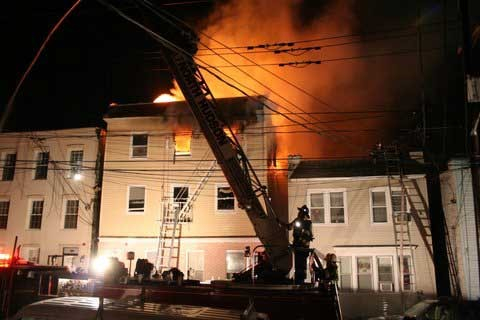Let’s discuss exposure issues and tactics over the next few installments. Where I worked in North Hudson (NJ) Regional Fire & Rescue, we almost never have a fire without an exposure concern. This concern must cause the Incident Commander to recognize that the stakes of the game have been raised and his or her actions to match and overcome those stakes will determine the outcome. It is OK to lose a building; it is sometimes an unavoidable part of the job, but to lose two or more when you had a chance to stop the loss by making early decisions such as summoning help early and taking proactive steps to get ahead of the fire with the correct deployment of people, water, and stuff is unacceptable. Fires are put out by people. When exposure issues rear their head, you must not only fight one fire, but you have to have the mindset that you will fight at least two (or three). Let’s look at some pictures:

(Photo by AA)
The three most significant issues when addressing exposures are distance, the wind, and building construction. When dealing with distance and wind, it is best to use the “Rule of 15” to decide whether the building should get significant attention as an exposure. The Rule of 15 states that an exposure 15 feet or less from the fire building and/or a 15 MH wind or better (or a combination thereof) must be considered an exposure threat and steps must be taken for protection. Building construction also has a major influence on whether the building ignites or not. Wood frame buildings are the most susceptible to extension because the whole thing burns. Next, what the wood frame construction is covered with can help or hinder or efforts. Beware what is beneath the vinyl siding. Once it melts off, you might have a more significant problem. In the photo above we see a vinyl sided building with asphalt shingle beneath. Here, the asphalt siding acted like a wick to spread fire into the floor above. This was on side C of the building. A little recon and a report to command might prompt a quick deployment of an exposure line to stop this spread. It does not take a lot of water to stop extension. Many homeowners have done it with a garden hose before the arrival of the fire department. A quick application of water to this wall would have stopped this autoexposure. But we need to know the threat is there. Does your department routinely send someone to look at the rear of the structure? Do they always give a report? Also, how much wind was present here? By the look of this, there was none. Remember that fire spread always occurs in the areas you are not looking in – make sure you cover the whole structure!!

(Photo by AA)
This building was about 75’ from the fire building which had fully involved wall made of asphalt shingle as well as well involved interior. The asphalt siding that was burning along with a wind condition extended the Rule of 15 here. Although the vinyl siding melted like taffy and all the windows were crazed and cracked, the asphalt siding prevented ignition of the exposed wall. The building next to it was a true ordinary constructed building (brick exterior) and had only a few cracked windows.

(Photo by Ron Jeffers)
Here is a situation where we have issues on both sides as in the last photo, but we have a much more severe exposure concern. The fire is well involved on the top floor of the fire building and seems to be burning through the combustible exterior wall on several sides. These are likely to be bearing walls so a severe collapse threat may exist. In this case, several actions must be conducted almost at once to keep the fire from spreading to the two buildings on either side. Not only do we need lines directed into the alleys between each exposure, but we need lines on the interior of each. We need searches and evacuations of both exposures as well. This will require not only additional personnel in each structure (usually a task force of two engines and one Ladder Company in each) but also a chief officer in each to decentralize your command and to reduce your span of control (and reduce the multi-company chatter on the radio). This is a multiple alarm job so there will be a lot of people to control. The only way to do this is by assigning Chief Officers to each exposure and to the fire building. Sounds easy right? All it takes is a recognition of what is burning, what can burn, how close it is, and what it is made of. Once that is known, identify what actions are required to proactively keep the exposures from becoming fire buildings. Then make sure you have or summon enough people in a timely manner to pull off your plan. Plans require people!
To summarize, when attending to closely-spaced, unattached buildings, the basics of protecting an exposure are:
- Assign someone to be in charge of it (Delegate)
- Get water on it if it to stop heat absorption (deck guns or 2- ½” lines)
- Watch the soffits
- Search and evacuate it
- Get lines inside it
- Close windows / remove combustibles
- Vent the unexposed side if feasible
- Check all areas for extension
- Salvage items –remember we are trying to save it – don’t trash it
- Progress report to Command must be made at regular intervals
More in the next installment